Midlatitude Forests
Mediterranean Woodland
The Mediterranean woodland is a sclerophyll
forest consisting of low branching trees with small hard
leaves and gnarled thick bark. The Mediterranean Woodland is found on west coast of continents in the midlatitudes and bordering the Mediterranean Sea, in close association with the
Mediterranean (Dry Summer Subtropical) climate.
Mediterranean woodland in North America is found along much of
coastal southern California. 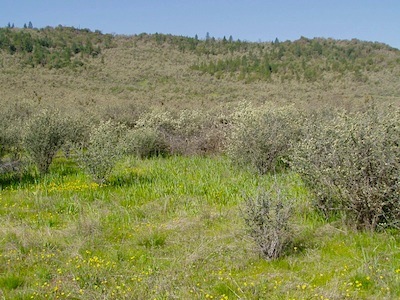
Figure 13.5 Chaparral vegetation typical of the Mediterranean Woodland. Courtesy USBLM
(Source)
Thick bark and small, waxy leaves are two adaptations to prevent excessive loss of moisture during the severe summer drought experienced in the dry summer subtropical climate. Chaparral vegetation grows to a height of 1 to 3 meters and has leathery leaves to prevent moisture loss. Chaparral has evolved fire-related adaptations as wildfires are common in this environment. Many chaparral species resprout and germinate after a fire. The cones of the Tecate cypress stay closed and on the tree until heat from a fire opens them and releases the seeds. Other species like toyon depend on resprouting from underground root systems that survive after a fire. Canopy of the typically hardwood, evergreen vegetation covers about 25 to 60 % of the terrain. The sparseness of the vegetative cover is due to the severe summer moisture stress and human disturbance.
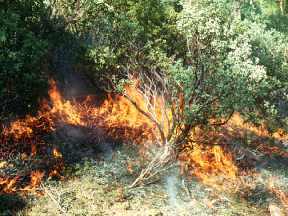
Figure 13.6 Chaparral
burning (USA). |
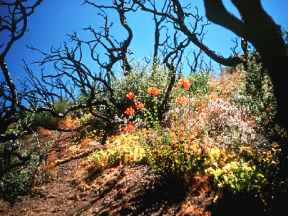
Figure 13.7 Wildflowers,
grasses, and shrubs regenerate after fire in the chaparral. (U.S.A.) |
Midlatitude Broadleaf Deciduous and Mixed Forest
The Midlatitude Broadleaf Deciduous and Mixed Forest of the humid midlatitudes contains evergreen and/or deciduous trees reaching heights of 15 to 25 meters. The broadleaf forest dominates equatorward, while toward the north, conifers intermingle to create a mixed forest. Needle leaf trees are well adapted to the cool to cold temperatures which occur on the poleward limits on the humid continental climate. Conifer needles are thicker than broadleaf leaves and have waxy coatings that promote water conservation. The small but large number of needles effectively capture a large percentage of sunlight, especially important during the the winter when sun angles are low. Cold sensitive broadleaf trees enter a period of vegetative dormancy, reducing moisture content and shedding their leaves. Oak, maple, hickory, chestnut and beech are common tree types found in the broadleaf deciduous forest. In most cases the forest is an open forest with little under story growth, though some shade tolerant annual species occupy the ground. The dense canopy inhibits significant amounts of light to penetrate to the forest floor inhibiting growth at ground level.
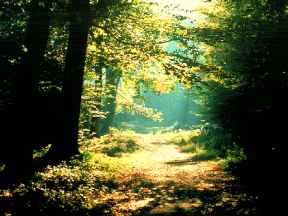 Figure 13.8 Broadleaf
deciduous forest in France. (Source: A.
Vorontzoff. FAO.)
Figure 13.8 Broadleaf
deciduous forest in France. (Source: A.
Vorontzoff. FAO.)
Many stands of different age and tree species are found together lending a patchwork character to the forest. The forest may be comprised of pure stands, or contain 2 to 3 species. Temperate forests are found in the Humid Continental climate and stretching into the Humid Subtropical Climate. Alfisol soils are found developing beneath much of the temperate midlatitude forest. Spodosols are found where conifers dominate.
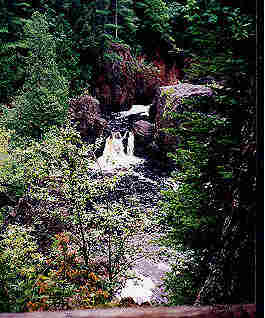
Figure 13.9 Mixed forest of Wisconsin, USA.
(Source: M. Ritter)
The midlatitude broadleaf deciduous and mixed forest has been drastically changed over time by human activities. By A.D. 1000, China was virtually "treeless". Much of England's forests had been cut by 1700. Today, acid rain threatens the temperate forest in many locations.